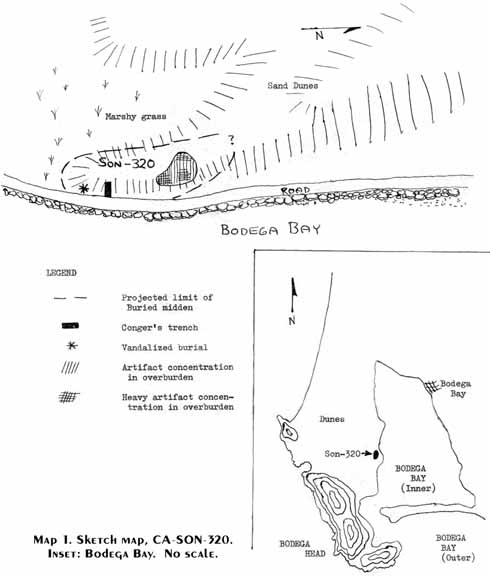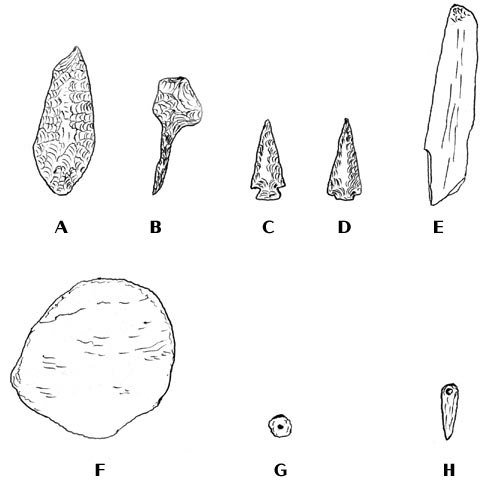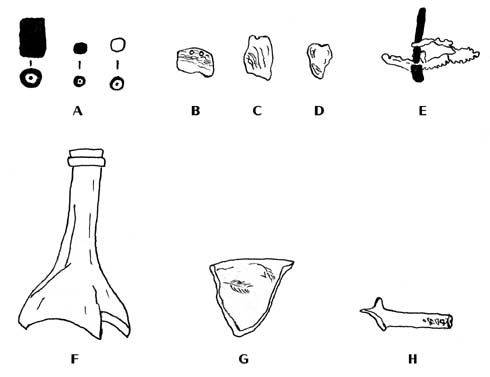CA-SON-320 is one of a series of extensive sand and shell middens lying along the west shore of Bodega Bay, on the coast of Sonoma County, California (Map 1). An adjacent site, CA-SON-299, was excavated some years ago by the University of California Archaeological Survey (Meighan 1955) and is said to have yielded material diagnostic of the McClure Complex of the Late or Middle Horizon (cf. Beardsley 1954). The site, however, has never been published. Several sites just south of CA-SON-320 were excavated as part of a salvage project for the Pacific Gas and Electric Company in connection with its abortive atomic power plant (Fredrickson 1963).

THE SITE
CA-SON-320 lies adjacent to the Bay, on and under a southeast striking dune, with a grassy valley to the west sloping up into another dune area that continues across Bodega Head to the Pacific Ocean. The midden, about 4 to 8 feet deep, is covered by 4 to 5 feet of sterile-appearing yellow sand, stabilized to some extent by dune grass and thorns, but largely loose and blowing. The midden appears from under this cover only along the east slope, where it is exposed by a road cut. This road was the original access to the outer head and the Gaffney Ranch, and more recently was improved to serve the P.G.&E.; project.
BURIALS
Mrs. rose Gaffney has recovered a quantity of material from CA-SON-320 as it has eroded into the Bay, and in the course of construction of the road that runs adjacent to it on the east. She reports one burial, deep in the site, containing eight obsidian prismatics, a worked bone presumed to be a sweat scraper, a perforated charmstone, a spindle charmstone, and two bottle-shaped charmstones (Gaffney/NCAS 1966).
In 1960 this writer had the questionable privilege of watching another burial "exposed" at CA-SON-320 by a classic unreformed pothunter. With a .38 revolver hung from a wild west cartridge belt on his hip, a pint of whiskey in his pocket, and a shiny new entrenching tool in hand, he was hacking through a burial rather high in the occupational deposit, shoveling bones over his shoulder and cursing his inability to find arrerheads. The burial was a pre-interment grave-pit burning situation, the partially scorched skeleton lying in a flexed position on its left side, aligned more-or-less east-west, head to the west, on top of a layer of charcoal and preserved unburned redwood. The well-armed excavator was not favorably inclined toward kibitzers, and only limited observations were possible.
EXCAVATIONS IN THE OCCUPATIONAL DEPOSIT
In 1960 Mr. Omar Conger began cutting an east-west trench through the site. Neither burials nor features were encountered, and artifact yield was low, in spite of the fact that all material was put through a 1/8" mesh screen. What artifacts there were seemed to be concentrated in the uppermost and lowermost zones of the midden, with the midden depths (18" to 36" approximately from the midden surface) being relatively sterile. The upper 18 inches or so yielded small corner-notched projectile points and a perforated steatite pendant; the lower two feet produced discoidal-to-irregular rectangular Olivella beads, a large Haliotis pendant blank, a possible bone strigil fragment, a leaf-shaped point and a large drill. A complete list of artifacts follows.
| Leaf-shaped point: 7 x 3 cm, obsidian, Fig. 1a | 1 |
| Leaf-shaped point fragments, obsidian | 2 |
| Drill: length 5.5 cm, butt width 2.3 cm, point width tapers from 0.9 cm to 0.3 cm, obsidian, Fig. 2b | 1 |
| Corner-notched point: length 3.4 cm, width at tang 1.3 cm, obsidian, Fig. 1c | 1 |
| Corner-notched point fragments (Fig. 1d) | 1 |
| Worked obsidian fragments | 8 |
| Possible strigil fragment: long bone section 10.4 x 4 x 2 cm, ground edges, deep irregular incisions longitudinally on concave surface. Fig. 1e | 1 |
| Haliotis blank: species rufescens. Irregular, diameter 6 to 6.5 cm, thickness 0.5 cm. Fig. 1f | 1 |
| Olivella beads: rough edges, drilled, irregular shape, average 0.6 cm diameter. Fig. 1g | 12 |
| Bone awl or needle fragment, 1.5 x 0.5 cm | 1 |
| Hematite lump | 1 |
| Steatite pendant: length 2.1 cm, width tapers from 0.5 to 0.2 cm, perforated. Fig. 2h | 1 |
In the fall of the year, surface collecting on the drift sand covering the site revealed quantities of burned glass trade beads, and the focus of operations was shifted. At this point Mr. Conger was joined by several other individuals, including the writer.
The Crew
Mr. Omar Conger directed excavations at CA-SON-320, assisted by the writer. Though a great many volunteered their assistance on the project, the contributions of Angelo Margolis, Richard Baldwin, and Donald and David Shields were particularly noteworthy.
EXCAVATION IN THE OVERBURDEN
The area where surface collecting had revealed burned glass beads was staked off in ten-foot units, but the extremely loose character of the drift sand combined with the attentions of numerous picnickers and Sunday drivers rendered data on artifact locations extremely inaccurate. General observations are relevant, however.
In an area about 50 feet across, a little to the north of the peak of the dune immediately covering the midden, glass beads and other material were scattered to a depth of about 18 inches, that is, about 30 to 40 inches above the projected level of the occupation layer. Most of the material was burned, but no concentrations of burned wood were recovered, and the sand was not noticeable discolored. Scattered fragments of well preserved charcoal were recovered, but never such as to constitute a coherent feature. In fact, no features of any kind were exposed, nor any clear evidence of burials. Artifacts, though scattered throughout the area, showed concentrations in the southeast, northwest, and south parts of the area. While artifact yield is very difficult to estimate under the circumstances, 100 artifacts per cubic yard of sand, including beads, is probably a low estimate.
ARTIFACTS
The following is a total list of artifacts recovered.
Beads
Something in the vicinity of 1500 beads were recovered, counting fragmentary specimens. The vast majority of these were glass trade beads, most of which were badly calcined. Only a rough count was possible considering the condition of the specimens.
Red (Red over white center, red over dark center, and indeterminate)
3-4 mm diameter: 145
5-7 mm diameter: 109
8-11 mm diameter: 35
White
3-4 mm diameter: 587
5-7 mm diameter: 450
8-11 mm diameter: 44
Dark Blue Hexagonal
5 mm diameter: 2 (or 3, counting one melted blue lump)
Light Blue
3 mm diameter: 2
Fused Clumps
About 50 clumps of beads fused by melting were recovered, each representing anywhere from 2 to 30 beads. Both red and white beads were found fused in strings, with no ascertainable consistency in the ordering of one to another, but most of the fusions are simply amorphous lumps.
Aboriginal Beads
Approximately 130 shell beads of various types were recovered, most burned to some degree and many in crumbling fragments.
Clam Disc Beads
5-20 mm diameter: 120
Clam tube beads
8 x 15 mm: 2
Clam disc blanks: 4
Olivella 3a1 thin-lip
7 mm diameter: 1
Olivella 3c saucer
5 mm diameter: 1
Olivella lopped-spire: 1
Olivella shells, unmodified: 3
Haliotis Pendants
Three pendant fragments were recovered, manufactured from the valve of an unidentifiable species of abalone (Haliotis sp.). One is perforated by two apparently monoconical holes midway along one edge; the other two show only remnants of single perforations. Virtually untypable, these specimens are illustrated in Fig. 2b, c, and d.

Figure 1. Artifacts Recovered from the Occupation Midden at CA-SON-320.
A. Leaf-shaped point. B. Drill. C-D. Corner-notched points. E. Strigil?
F. Haliotis pendant blank. G. Olivella bead. H. Steatite pendant. No scale.
Objects of Metal
| Brass suspender buckle | 1 | | Rifle butt-plate | 1 |
| Brass rivets | 3 | | Sheet iron fragments | 2 |
| Brass hook of hook-and-eye assembly | 1 | | Iron pot fragment | 1 |
| Brass washer on iron pin | 1 | | Lead slugs, .22 cal.* | 4 |
| Iron suspender buckle | 1 | | Lead slugs, ca. .45 cal.* | 1 |
Iron spikes, nails, and pins (rusted
badly) | 24 | | Lead "split-shot" fishline
weight | 1 |
Iron shaft attached to lead(?) gear
wheel fragments (Fig. 2e) | 1 | | Front draft assembly from
wood-burning stove | 1 |
| Iron buttons | 3 | | Melted lead lumps | 3 |
| Lead birdshot pellets | 12 | | * Probably intrusive | |

Figure 2. Artifacts Recovered from the Sand Overburden at CA-SON-320.
A. Trade beads. B-D. Haliotis pendants. E. Lead(?) gear wheel on iron shaft.
F. Green, turn-mold, wine bottle. G. Porcelain sherd. H. Pipe stem. No scale.
Porcelain
| Dish: White, crackled glaze, raised lozenge, line & cross-hatch design | 5 sherds |
| Dish: White, smooth glaze, raised floral design (Fig. 2g) | 7 sherds |
| Cup(?): White, heavy; raised floral design | 1 sherd |
| Cup: White, heavy, no design. Handle fragment attached | 4 sherds |
| Dish: White, plain | 2 sherds |
| Dish: Yellow-white, plain | 1 sherd |
| Dish(?): White with indeterminate grey design | 2 sherds |
| Cup(?): Grey-white with poorly applied red line around outside of rim | 1 sherd |
| Bowl: White, heavy, plain. Badly burned | 6 sherds |
| Cup: Wheel-turned ware with dark brown slip | 1 sherd |
| Cup handles | 3 sherds |
| Untypable | 6 sherds |
Clay Pipe Stem
| 4.6 cm long, broken at attachment to bowl (Fig. 2h) | 1 frag. |
Glass (identified by Michael Mannion)
| Green, turn-mold wine bottle | 2 sherds |
| Black, dip-mold, applied-lip beer or ale bottle | 1 sherd |
Black glass, fragment of a hollow, machined object. Raised design
on convex surface resembles flowing hair | 1 sherd |
Stone
| Obsidian, unmodified | 8 flakes |
| Chert, unmodified | 6 flakes
1 core |
| Chert drill | 1 |
Bone
Bird bone: 4.3 cm long, both ends beveled and snapped. Small
incision 2 mm from one end. Bead blank? | 1 |
| (Marine?) mammal long bone fragment | 1 |
Carbonized Seeds
Acorns: Evidently Tanbark Oak (Lithocarpus densiflora) or Valley
Oak (Quercus lobata) | 31 |
| Grass seeds resembling wheat | 100 ( ± ) |
Leather
Carbonized fragments of shoes, uppers and soles, in
disintegrating condition | 15 ( ± ) |
DATING
The following notation appeared in the Diggers Digest, Vol. 1, No. 2, April 1, 1962:
Dating Our Trade Beads
A selection of the trade beads from the Bodega Bay Site (Son-299)* and the Cache Creek site (as yet unidentified)** were submitted to Mr. Arthur Woodward for analysis.
Mr. Woodward is now Curator of Collections for the Arizona Historical Society in Tucson. He is also probably the foremost authority on aboriginal trade material in this country.
He stated that our beads are typical of the material found in the upper San Joaquin Valley and have a temporal range from 1830 to 1870 or 1880. The beads were sold by the hundreds of pounds by the merchants of San Francisco, for eventual sale to the Indians for gold.
* Mistaken identification from local sources
** CA-COL-11. Screening a vandal's backdirt had yielded thousands of beads and other artifacts. Site has been more recently excavated and NCAS collection analyzed by Mrs. Patti Johnson , U.C. Davis
The turn-mold wine bottle fragments recovered from CA-SON-320 were identified by Michael Mannion as ranging in time from about 1875 to 1920, while the dip-mold beer or ale bottles range from about 1855 to 1880.
The dates proposed for beads and bottles seem to coincide fairly well, and would seem to place the advent of the artifacts in the overburden at CA-SON-320 sometime in the period 1875-1890.
CONCLUSIONS
Represented at CA-SON-320 are two quite distinct sites: one occupational, one perhaps something else. The relationship between the two, if one exists, is hazy.
The occupational zone at-CA-SON-320 is a typical California coastal shell midden; simply the accumulation of debris from many years of village life. While its lower levels might be associated with occupation by the people of the McClure Complex, insufficient work has been done to permit any real assignment. The upper level would appear to date from the Late Horizon, perhaps associated with something akin to the Estero facies in the Point Reyes area (Beardsley 1954). This is the suggested inference to be drawn from the presence within the site of small corner-notched points presumably for use on arrows, and of a pre-interment grave-pit burning, a Late Horizon, Phase II indicator in the Lillard, Heizer, and Fenenga scheme (1939). No evidence was recorded of a historic phase in the occupation zone, though ethnographic sources indicate the presence of a historic camp somewhere in the vicinity (Sally Ballard, Coast Miwok, personal communication to Edith Vaughn, Santa Rosa).
Sometime in the late 19th century, after the deposition of some 4 feet of drift sand on top of the occupation midden, an event took place involving the burning of large quantities of objects. The burning in this second phase was not the kind of long-term cooking that, with the discarding of waste material, results in a midden; it was a rapid incineration that left little or no trace beyond the artifacts that it partially consumed.
Two explanations for the situation appear plausible. First, a short-term village may have been consumed by fire. If it had not been occupied for long it could explain the lack of midden and of any kind of extensive food refuse. An alternative is that CA-SON-320 was the site of a ceremonial observance involving the voluntary burning of goods. This sort of activity was associated with the mourning anniversary observed by many groups in southern California and the Sierra Nevada region. The elements and distribution of the mourning anniversary were discussed by Kroeber (1922), who suggested that the sacrifice of goods at the time of burial among the Pomo was a related trait. The Pomo inhabited lands immediately north of Bodega Bay, and seem to have used the Bay in common with the Coast Miwok (Kniffen 1939).
Heizer and Elsasser (1964) suggest that the southern California and Sierran mourning anniversary, the central California grave-pit burning tradition, the Pomo practices, and the cremations on Gunther Island in Humboldt Bay represent a pattern of idealogical diffusion from south to north. It is possible that the overburden component at CA-SON-320 reflects some sort of activity associated with these practices.
The CA-SON-320 collection is in the possession of the Northwestern California Archaeological Society, Boyd Museum, San Rafael.
REFERENCES
Beardsley, R.K. 1954. Temporal and Areal Relationships in Central California Archaeology, Part 1. Reports of the University of California Archaeological Survey 24.
Fredrickson, D. 1963. Archaeological Investigations within Unit No. 1 of Pacific Gas and Electric Company's Atomic Park, Sonoma County, California. Ms.
Gaffney, R., with NCAS. 1966. Catalog of theRose Gaffney Collection. Ms. NCAS.
Heizer, R.F. and A.B. Elsasser. 1964. Archaeology of Hum-67, the Gunther Island Site in Humboldt Bay, California. Reports of the University of California Archaeological Survey 62.
Kniffen, F.B. 1939. Pomo Geography. University of California Publications in American Archaeology and Ethnology 36(6).
Kroeber, A.L. 1922. Elements of Culture in Native California. University of California Publications in American Archaeology and Ethnology 13(8).
Lillard, J.B., R.F. Heizer and F. Fenenga. An Intoduction to the Archaeology of Central California. Sacramento Junior College, Department of Anthropology Bulletin 2.
Meighan, C.W. 1955. The Archaeology of the North Coast Ranges, California. Reports of the University of California Archaeological Survey 30.





